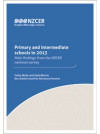This report presents the main findings from the NZCER national survey of primary and intermediate schools, conducted in July and August 2013. It reports on the views of principals, teachers, boards of trustees and parents. It covers many aspects of school experience, including school resources, school interactions with government agencies, the New Zealand Curriculum in schools, National Standards, student wellbeing, and use of technology.
Key Results
Our primary and intermediate schools were in mixed health in 2013. Parents’ views of the quality of their child’s education remained positive, with a small increase in those reporting clearer information on their children’s progress. Only 6 percent could not access the school of their first choice, indicating that lack of school choice is not a major issue in our education provision.
Trustees seemed more confident about their responsibilities than in 2010. Key elements in their perceived role as trustees were setting a strategic direction, supporting school staff, and representing parents, rather than employing principals or acting as agents of government. Forty four percent of trustees would like more training or support, and most saw the Ministry of Education as having a role in advising and working with them. Parents appeared to be raising more issues with school boards—more in relation to student behaviour, school access, resources and property than to student achievement. Continuity in school boards across the May 2013 triennial board elections was reasonably high: only 20 percent of boards lost four or more of their previous members.
Fourteen percent of principals thought their board was merely coping (29 percent of decile 1–2 school principals thought this). Principals were largely positive about their boards adding value to the school, but 46 percent also thought they required a lot of school management support to do so. Principals and teachers continued to have high levels of enjoyment of the work they do, but they were becoming over-stretched. This was indicated by slippages in principal and teacher morale and increases in stress levels since 2010. Attention to National Standards work saw some positive reports of professional learning, particularly in the use of moderation and teachers working together more, but on the whole principals and teachers did not find that their National Standards work was improving student achievement. They remained sceptical about the Standards achieving this purpose.
The survey provides some evidence that it is difficult for primary and intermediate schools to make further progress on NZC on their own, without more coherent and available support and systematic ways to share and build knowledge. Changes in teaching practice and the ways teachers work together were evident between 2007 and 2010, but further progress seems to have stalled. ICT and e-learning—a focus for many schools—were positively viewed, but here, too, there was no progress evident from 2010 in the ways that might really change learning. What had increased was the use of ICT for students to practise skills, a use consistent with the focus on National Standards.
School resources remained stretched. Only 11 percent of primary and intermediate principals thought their government operational funding met their school’s needs, the same as in 2010. School budgets were variable, sometimes making planning difficult. Perhaps linked to the greater expectations that schools will raise student achievement was a marked decrease in the proportion of principals who believed their school’s teaching staffing entitlement is adequate: 29 percent thought this in 2013, compared with 48 percent in 2010.
While most schools had some interaction with other schools, and more were clustering to pool resources for administrative support (26 percent, compared with 10 percent in 2010), 59 percent of schools reported direct competition for students. Enrolment zones appeared to protect the rolls of some schools while allowing them to take students from other schools’ areas, with 41 percent of schools with enrolment zones taking at least a fifth of their students from outside their own zone. Sixteen percent of primary principals were spending more on marketing or other aspects of their school than they would like in order to encourage enrolments.
Decile 1–2 schools continued to face greater difficulties with filling teaching positions with good staff, school competition and student mobility.
Overall, the Ministry of Education appears to be undertaking more local work with schools than in 2010. Principals’ views of this work show a wider variation than one would want for interactions that should be providing schools with robust information, advice and challenge. Senior advisers, assigned to provide a single point of contact and advice, did not have high continuity, and fewer than half the principals thought their senior adviser understood their school

